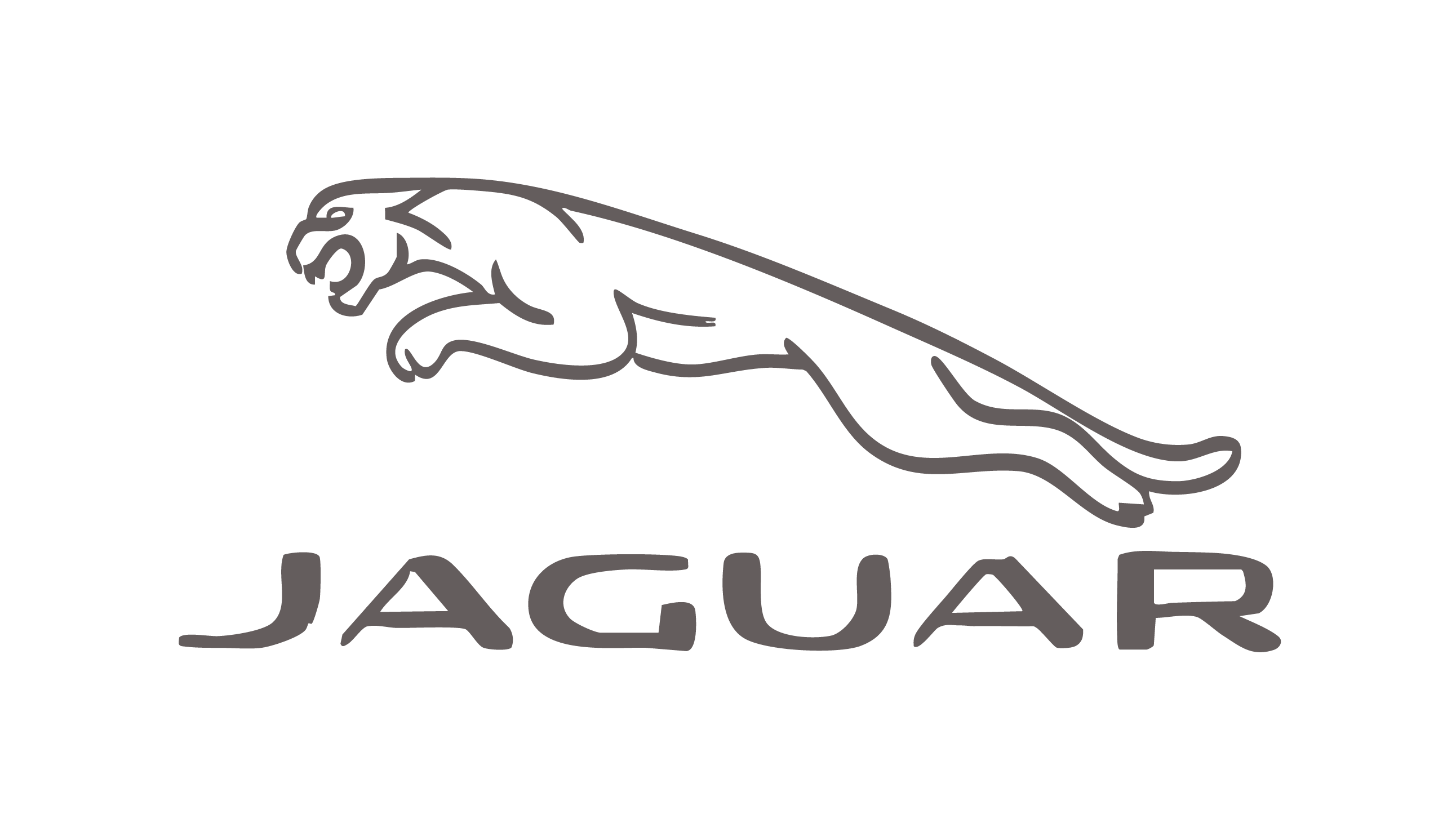
Killing the Cat
Audio Recording by George Hahn
Jaguar, a brand that’s been in a coma for years, is trying to wake up … and it’s gasping. The car-free “Copy Nothing” kickoff video and the rollout of a pink concept EV at Art Basel Miami have inspired well-earned mockery. The launch rivaled Elon’s “We Robot” event for the “all chip, no salsa” product launch of 2024. Getting attention is key to any marketing campaign, so mission accomplished. Sort of.
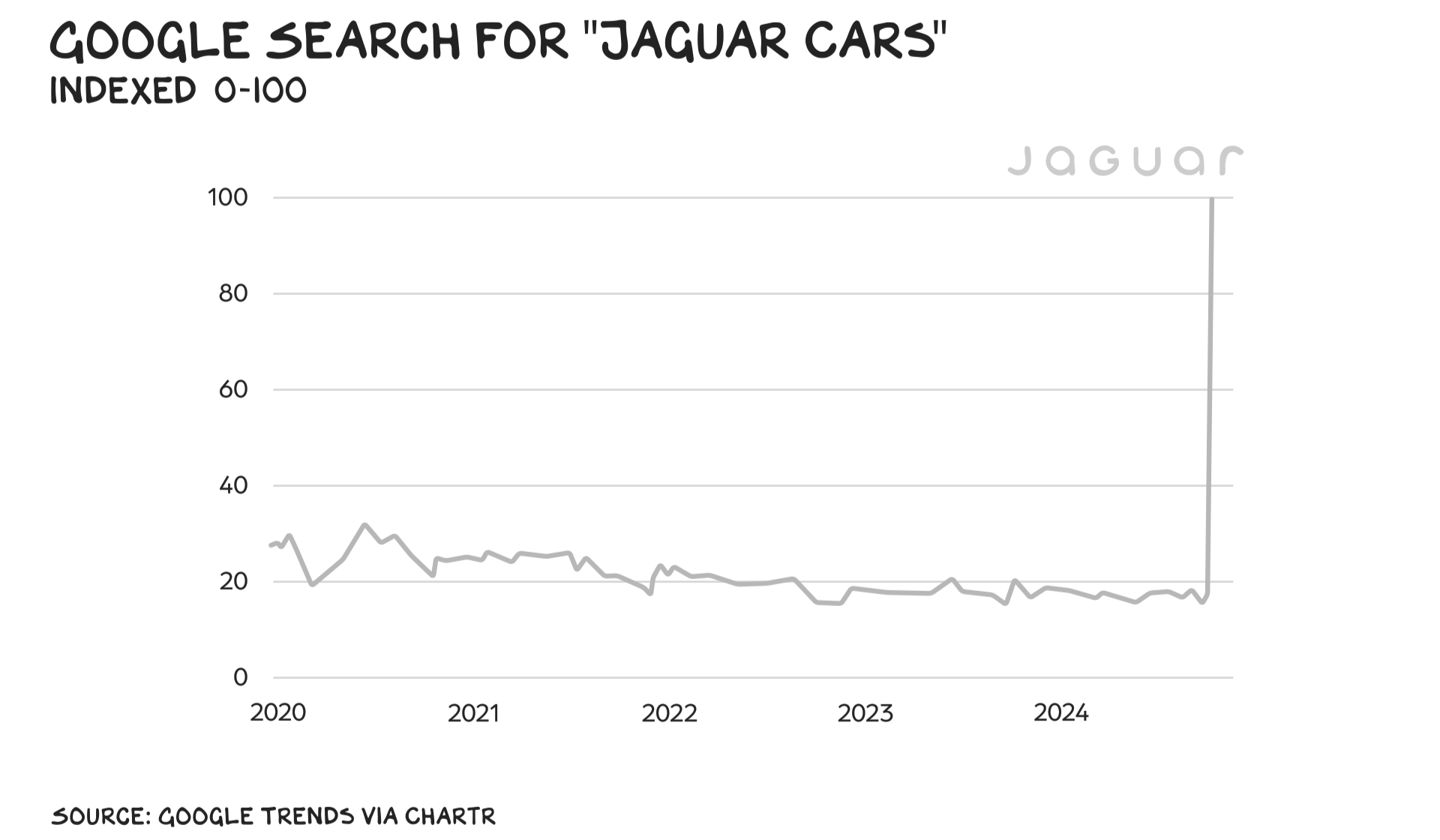
Tata Motors, which owns Jaguar and its stablemate Land Rover, has also succeeded in further eroding what’s left of Jaguar’s brand equity. Jaguar trashed its iconic logo, all its current models, and its traditional promise of speed, power, and elegance. In their place is an uninspired and generic brand mark, a concept model that will never be put into production, and an incomprehensible promise: something about good-looking people, bright colors, and exotic haircuts.
A lot has been said about this HBR case study that’s writing itself, including some predictable culture war bullshit about Jaguar having gone woke. Most of this misses the larger point, which is that Jaguar’s move is further proof that the brand age is over.
Do No Harm
Just as doctors have a Hippocratic oath, chief marketing officers ought to have a similar pledge: “First, do no harm…”
I’ve advised lots of big consumer brands about their marketing, and I’ve noticed that CMOs recognize their days are numbered and are desperate to show visible motion, whether it makes sense or not. Often that activity, devoid of progress, means spending lots of money on a “new” agency stocked with sharply dressed young people who will host events giving awards to whoever’s spent the most money across the advertising industrial complex. “I’m honored to be part of this brand’s history and am shocked how well my predecessors managed the brand,” said no new CMO ever. The typical incoming speech: “Thank God I’m here — we need to redo everything.”
Which is usually self-defeating. For about 50 years following World War II, it was good business to churn out a mediocre product and then surround it with emotion (i.e., branding). On any given night about 60% of America was in one of three places, ABC, CBS, or NBC. Via the miracle of TV advertising, a few cents’ worth of peanut paste could be transubstantiated into a jar of maternal love, as “Choosy mothers choose Jif.”
In the age of the internet, network television is in hospice. Exhibit A: the proposed merger of Omnicom and Interpublic. When I started Prophet, a brand strategy consultancy, these firms were the Alphabets and Metas of the economy; now they’re consolidating, two emaciated polar bears fighting over fewer seals and sharing a melting piece of ice. The previous sentence is both awful and wonderful. Mostly the former.
Brands mean a lot less than they used to. Consumers now have a range of weapons of mass diligence to help them find and rate products, starting with Google and social media. I travel constantly, so I used to rely on well-known brands when booking hotels in cities I didn’t know well. The name Mandarin Oriental, or Four Seasons, meant I could consistently expect and get a 7- or 8-level customer experience. Lately, though, I’ve been using ChatGPT and other AI tools to find 9s that better fit the moment, and me: the gym at The Soho House Berlin; the rooftop restaurant at the Waldorf in Beverly Hills, the bar at Chiltern Firehouse. If I sound like a privileged douchebag, trust your instincts.
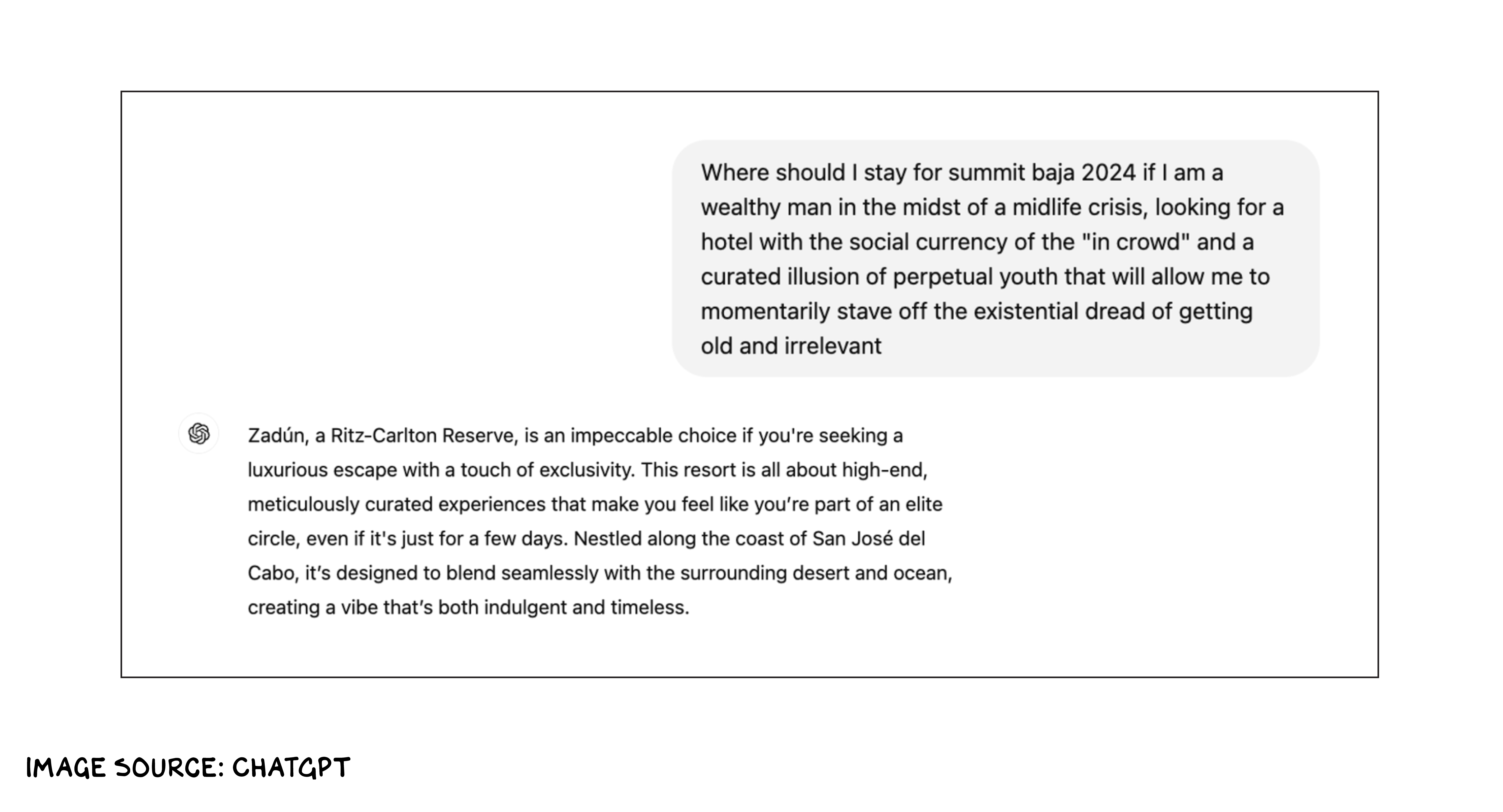
The internet has diminished the power of even strong brands, and it’s penetrated the shield of good branding from mediocre products (e.g., Nike, Intel, Target, etc.). A product or service that cannot fulfill its promise to make you smarter or sexier can’t reverse its fortunes by listening to Don Draper. And inventing and refining a great product, fixing its supply chain, and improving your customer service is a lot more work than turning to Midjourney and asking for a new logo.
No Sale
Jaguar’s problem for a long time has been products that didn’t live up to the brand promise. Well after its swinging London ’60s heyday, Ford bought the company in 1989, and it’s now owned by India’s Tata. It still manufactures the cars in Coventry, U.K., thus technically preserving the Britishness that’s key to its brand identity.
Although they’ve improved, the cars continue to be dogged by a lingering reputation as mechanical nightmares. Anybody who drove one was making the statement: “I am a gangster who probably owns two of these status symbols, because one is always in the shop.” Stylewise, Jaguar’s current lineup has little of the elan of the legendary E-type or other classic models. In terms of sales in the premium car market, Jaguar is an afterthought behind category leaders BMW and Audi. With a few exceptions, Jaguar hasn’t been able to make anything in the $50,000+ price range that anybody wants to buy.
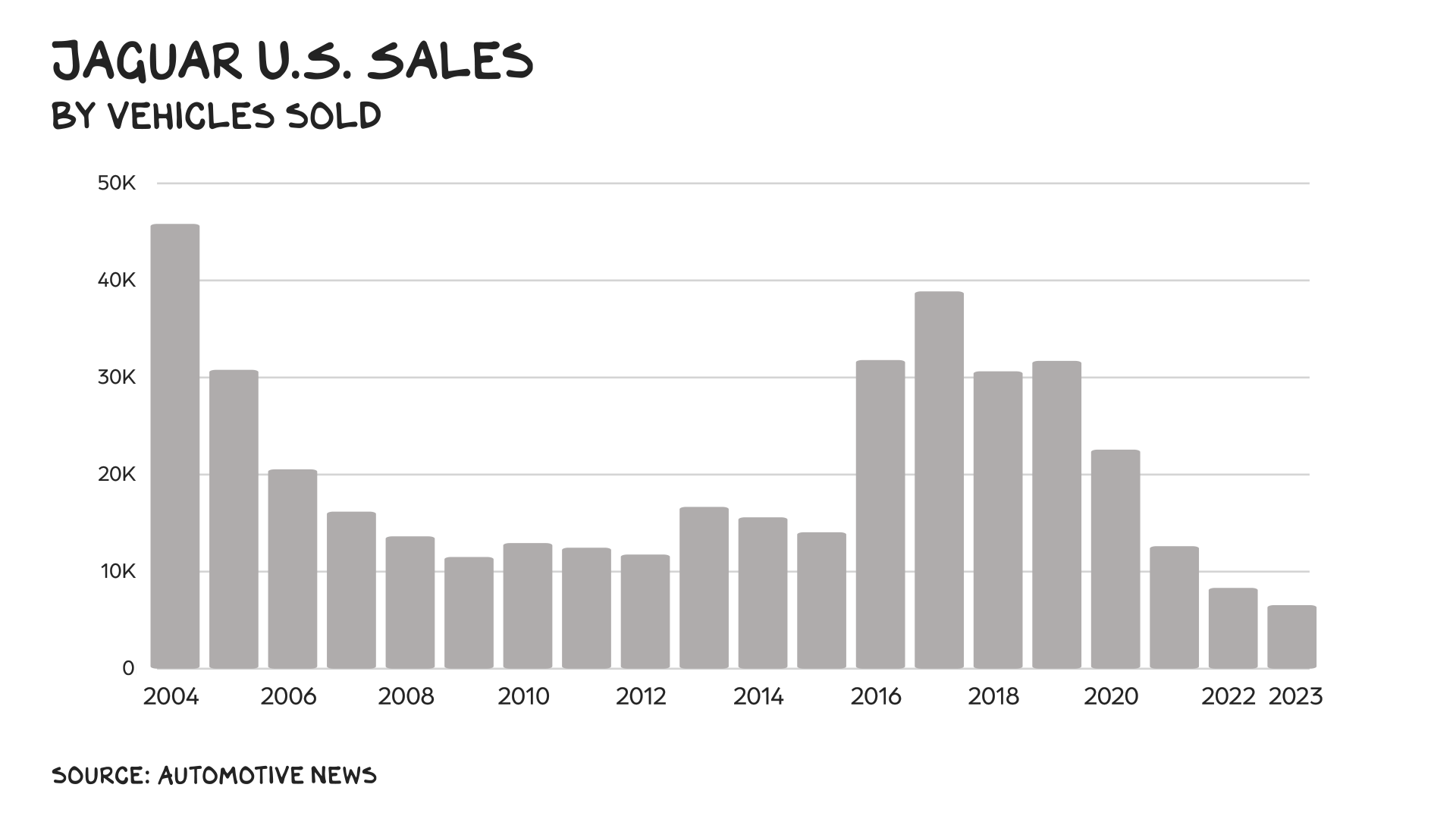
Jaguar’s current business response to this makes sense: Management decided to wind the company down and relaunch it. Jaguar is ending production of its three current models and retooling to produce an all-new all-electric line. It’s also decided to abandon the premium market and go further upscale into luxury cars priced at around $400,000. This is a smaller market with fatter margins, so the company is closing some dealerships.
All of which points to something that’s gone mostly unremarked in the chatter about Jaguar’s rebrand. The move is another symptom of growing global income inequality. New billionaires are being minted at a rate of about 270 per year, while the middle class — even at the upper reaches, what marketers call the “mass affluent” — continues to disappear. Jaguar doesn’t see any growth selling to lawyers and dentists, but it does see a future selling to entrepreneurs and financiers.
It’s going to be at least a year, however, before any new-era Jaguars go on sale. No one outside the company knows how they will look or what will be under the hood. The clunky pink Type 00 sports-tank Jaguar introduced in Miami is a concept car: It will never go into production. I’ve been to a lot of car conventions and seen a lot of concept cars. In my view, they are a waste of effort and money, no matter how sexy. They’re shiny one-off marketing props. Ivanka Trump is (seriously) more likely to be president than the Tesla Robovan is to ever be produced.
Talking Pictures
So, with a dark year ahead of it and no new product ready to show customers, Jaguar decided to fix the one thing that wasn’t broken.
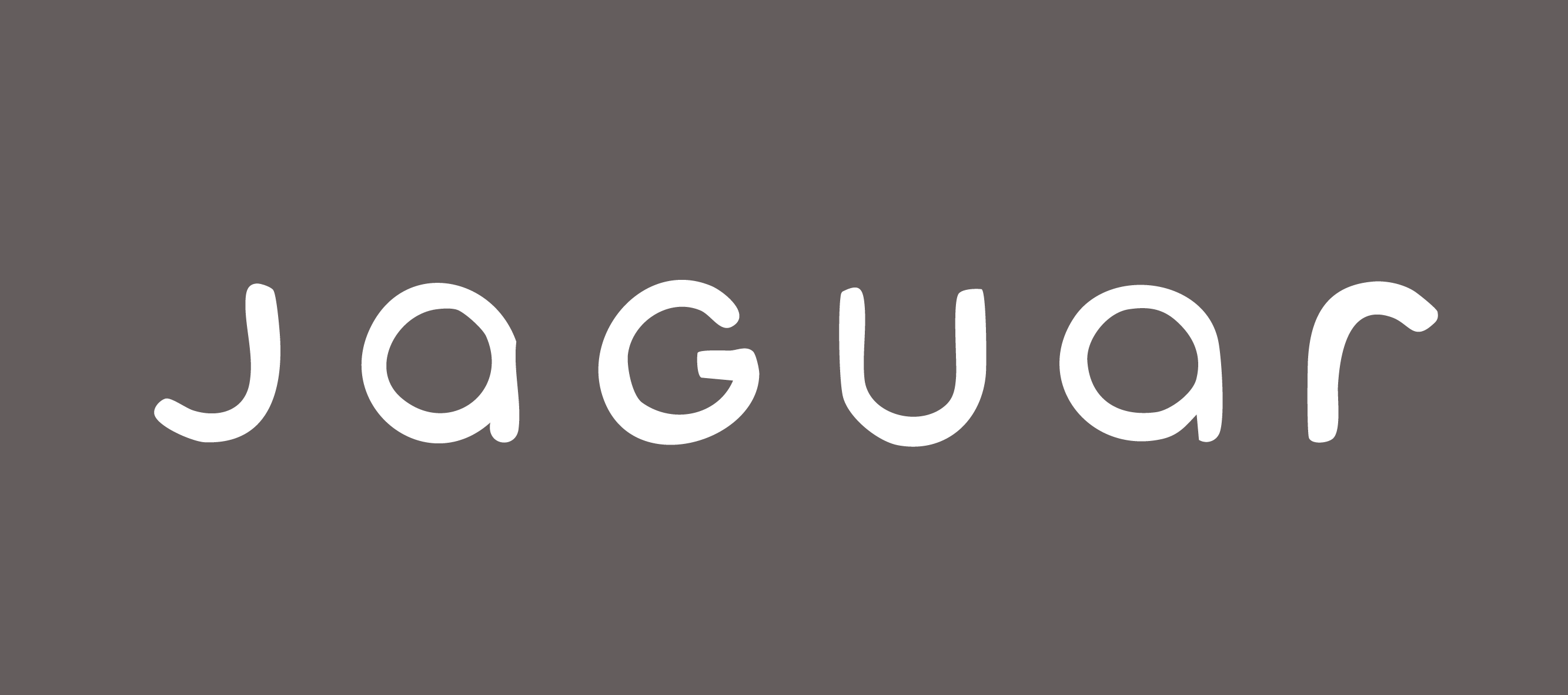
The new brand mark makes it seem Jaguar is relaunching as an AI consulting firm. The logo looks as if it was designed by AI and never tested with real people. According to one respondent to an entirely un-scientific survey I conducted on Instagram, it “would be a great logo for a kitchen knife set.”
One of the most precious things a company can possess is a powerful logo, one that imprints itself on the eye and instantly tells the brand’s story. Humans are visually oriented. Written language is only about 5,000 years old, and the printing press is less than 600 years old, but visual communication via drawn or painted images dates back to our Neanderthal ancestors. That’s right — it may even predate our existence as a species. We process visual information about 60,000 times faster than we do words. Researchers at MIT once estimated that the human brain can correctly identify an image in as little as 13 milliseconds.
When I talk about logos in my marketing class, I demonstrate their power by asking students if they can identify a mark using just their peripheral vision. Great logos — the Nike swoosh, the McDonald’s arches, the Mercedes “three-pointed star” — are immediately recognizable even almost outside our plane of vision. An effective logo needs to be meaningful, resonant, distinctive, and scalable. Jaguar’s pouncing cat, which it called the “leaper,” was all that.
There are few things in nature stronger and more agile than a jaguar. As sleek and beautiful as they are lethal, they’re the apex predator of South America’s jungles and deserts. Stealthy and fast, they kill by pouncing from behind and piercing their prey’s skulls with jaws and teeth capable of penetrating artillery shells. Also, they’re the only animals that, when hunted, will turn around and hunt their hunters. (Not really, but go with it. It’s on-brand for the cat.) Jaguars look arrogant AF and rightfully so. The old logo and mark told that story; the new logo says “We hired some MIT grads who, for $800k, told us to lay off everyone in our customer service department and replace them with Salesforce’s Agentforce.”
Jaguar’s leaper now survives only in a faint echo of the original, the negative space in a field of horizontal lines on a small side panel of the Type 00. To take the greatest visual metaphor in automotive history and kill it is to destroy shareholder value. It’s the essence of CMO malpractice. It’s just as stupid and wasteful as if Disney responded to a spate of weak releases by taking Mickey, Moana, Darth Vader, and Elsa out and shooting them.
It’s also a rejection of everything that ever made Jaguar … Jaguar. Not just the grace and power of the animal, but also the brand’s Britishness. There is nothing feline or Rule Britannia about the Type 00. And for all that talk about “Copy Nothing,” the car’s silhouette is reminiscent of the Rolls-Royce Spectre, and its sharp edges and lines recall the Cybertruck. The Jaguar people who signed off on all this richly deserve to have their careers pounced on.
Think Different
Branding is about differentiation and creating a sense of scarcity. That means leaning into whatever you have that makes you stand out. If you’re going bald, shave your head completely. If you’re a tall woman, wear heels. If you need glasses, get the biggest pair you can find.
Jaguar is abandoning its differentiators while at the same time trying to enter the high-end luxury market, where being singular is the whole shooting match. The higher you go in price, the more eccentric it gets.
In my view, Jaguar should not have spent a dollar on marketing before it had an inspiring, ready-to-ship product to show the public.
The companies that have added the most value in the past 10 years barely advertise at all. Netflix now has a market cap of about $400b; in 2014 it was about $21b. Alphabet’s market cap 10 years ago was roughly $390b; today it is $2.5t.
Those companies and others took dollars out of advertising and put them into making better products and getting them to customers faster and cheaper than their competitors. Amazon didn’t win e-commerce with a marketing campaign; it won by doing the hard work of guaranteeing free delivery in 48 hours. Others have won by going asset light: Nvidia uses suppliers for all of its manufacturing; Shein, the fastest-growing apparel company in the world, has no stores and no warehouses.
It’s not too late for Jaguar to ditch its rebrand and start all over again with a strategy where a great product is not an afterthought to a marketing campaign. This is, in a way, an opportunity to announce that, after a huge outpouring of goodwill toward the iconic metaphor, they are going “Old Coke” and reverting. However, we shouldn’t hold our breath. The current landscape of reality-TV stars and misinformation has rid the corporate world of one important and simple phrase: “We fucked up.”
Life is so rich,

P.S. If you haven’t done so already, we would appreciate your help by taking 2 or 3 minutes to fill out this survey. We are trying to understand more about our readers. Thank you.
P.P.S. Section is hosting an exclusive AI Executive Leadership Workshop at the HumanX conference in March. Promo code HX25p_Section gets you $250 off your ticket price. Get it before prices increase.
40 Comments
Need more Scott in your life?
The Prof G Markets Pod now has a newsletter edition. Sign up here to receive it every Monday. What a thrill.


A few things I have learned through my travels and one of them is that you can’t return to the past and expect it to be the same. The E type keeps being brought up but they can’t make another E type. Move on using that history and those lessons learned and stop living in the past. Even with that make a car that you don’t have to tie a garbage bag to the bumper when you drive so you can collect the parts as they fall off and rebuild it when it stops. Slow down and build a quality product including your new logo and image.
Dont think Tata cares about our emo-nostagic opinions when it looks at the fast-growing numbers of young Asian, Mideast, African millionaires who have no allegiance to the old Jaguar label nor the same-old same-old cookie cutter deisigns of North American and EU brands. Im guessing that Tata’s market will quickly outpace the new Old World’s sales for cool, upscale driving.
Jaguar has missed the mark so drastically they ended up over the neighbors fence and are never getting their ball back. Their target audience are luxury enthusiasts who are passionate about craftsmanship, sophistication and exclusivity. This new logo says “I need to work on my penmanship”. This is the epitome of the ‘Graphic Design is my Passion’ meme.
Boy are you ‘right on’ about Jaguar, and even more about Land/Range Rover, which does ‘deserve’ its article, IMO.
Both are bad brands by reputation and Consumer Reports articles – unreliable, overpriced, and frankly tired status symbols.
British cars have been notoriously unreliable for 50+ years, And the Mini, while ‘sort of British’ is owned by BMW.
Appreciate your ‘smart snark’ always. Keep it up.
Bill
I admire your use of data in your articles, which I often share as examples to make a larger point with my marketing students about proof vs. opinion.
Hi Bill, have you ever owned a Jaguar in the last 20 years, I have 3 Jaguars of various ages, a 2003 XJ V6 petrol (which to date has had a new air pump, several sets of tyres & 2 batteries in its 20 plus years life, my 2016 Jaguar F type V8 coupe has only cost me tyres to date & my 2019 Jaguar I pace has only cost me the cost of one 2 year service , so maybe I am just lucky, but I have talked to other long term Jaguar owners & they seem to have reliable cars they love as well. My wife is on her second RR Evoque in 4 years & again, both faultless during the time we have driven them, again maybe we are lucky. In no way am I saying both brands are perfect, but I would not swap my F Type or I Pace for many other cars of similar price, just the opinion of an actual Jaguar customer, happy with their cars.
As the owner of Brand Canyon, an Arizona agency, I agree with you 100%. During my thirty-plus years in this industry, I’ve seen branding devolve from an absolute necessity to many a consultant’s shuck and jive. It’s exactly as you describe it (no surprise there, you’re pretty good at this shit). Social media has become the ultimate litmus test, exposing whether a company truly “walks the walk.” Branding isn’t unnecessary but the real business will out. Clever or clandestine feeds won’t mask the truth for long: what most companies say about their products or services is met with far more skepticism than enthusiasm.
Our mantra is pretty simple: “Your brand is the promise your business makes.” My message to clients is even more straightforward—if you can’t keep the promises you make to your customers, no amount of branding will save you. Even if you’re Jaguar.
I’d actually consider getting one eventually. The old brand screamed Boomer AF. The next billionaires are coming from crypto and AI and they don’t want a brand that smells old.
Transition is always the toughest journey in business. Jaguar in the minds of most people has dined out on the E-Type, the XK120 and perhaps the Mk2, much loved by British villains as a getaway car. Fewer have experienced more modern Jags and their eccentric build quality. In that context of heritage, it is easy to move quickly to judgement. I have no idea if a reborn Jaguar will be more successful or not but I am intrigued by the journey they are mapping, supposedly unencumbered by the Sisyphean stone of yesterday. I shall pause until the end of 2025 and see what emerges. To judge a logo out of a new context seems rash and everything that the marketing team expected, but to disappear from public discourse entirely would have been fatal, as it was for MG. They are not rushing to defend it in any meaningful sense, which is right. It could be a Dead Leaf butterfly or a Birdwing. Won;t it be interesting to find out?
Loved the expression” weapons of mass diligence”.
Interesting article. I agree. I leased a 2023 XF last year because it was the British Racing Green with Tan interior… about the most beautiful and old school color combo I have ever seen. I have driven most of the luxury brands.The jag by no means drives like any of those (in a bad way). There is not enough room here for my fixit list. I did crash into a guard rail to avoid a car,and both passenger side doors are wrecked enough they must be replaced. It’s drivable, but clearly has been hit hard. I have been waiting over 6 months for the parts to come in. Been driving this junky looking thing around. Not a good look driving up to valet at a party etc. THEN THE AD CAME OUT! I was appalled. I would never buy a car to make a political statement. Then the CEO calls us VILE & INTOLERANT! He’s calling his PAYING customers VILE, because why? What did we do? I have called hoping to turn in my car in early since I’m vile, and the parts are still not even in the US. They don’t answer their phone.According to online agreement it’s thousands to turn in early and with damage. I understand this isn’t the Jaguar complaint department, and I’m grateful to even have a luxury car to drive. Its the total lack of customer care. This is their way of fixing Jag’s problem, a “rebrand”. Since their new cars are going to be pink, $400k, and only for the tech and bitcoin 25 year olds (plenty of those to sustain an entire car company…. Smart strategy).
The E-Type is stunning. Interesting that during the height of brutalism in the 1960s, where buildings look like rotting concrete rectangles, cars were never more beautifully and individually designed.
It’s a pity what’s happened recently with Jaguar. I rented the F-Pace a few times in 2020 for long road trips, and really liked it. I was happy with the revival, and I would have bought one had I needed a car.
… Tried to do your survey but after saying I didn’t subscribe to your newsletter (question 2) it informed me I wasn’t a good fit to complete the survey.
I read your blog post every week, guess that’s not enough to ‘fit’.
Unless it’s a deliberate ploy to get people to sign up? … Didn’t work.
Thanks Scott, time to buy the thickest glasses I can find. Appreciate the wit and humour in this article 🙂
“Branding is about differentiation and creating a sense of scarcity. That means leaning into whatever you have that makes you stand out. If you’re going bald, shave your head completely. If you’re a tall woman, wear heels. If you need glasses, get the biggest pair you can find. “
I appreciate Scott’s honest self reflection on his success. I’m grateful he doesn’t hide it, and more grateful he shows humility and gratitude it. As Sam Harris points out, there is no such thing as a self made man, luck plays a large part. Most wealthy people appear not to realize this and in our social age make their hubris a public burden. Gone are the days when such people would be a burden only to their inner circle. Nowadays, we’re all sucked into that crushing black hole. As Scott himself has pointed out, wealth inequality is most often addressed by crowds with torches.
Arguably the weakest of the pieces.
“The companies that have added the most value in the past 10 years barely advertise at all. Netflix now has a market cap of about $400b; in 2014 it was about $21b. Alphabet’s market cap 10 years ago was roughly $390b; today it is $2.5t. “
You comparing a predominantly B2B company’s lack of advertising to make that point?! Apple who added significant value is one of the largest advertisers.
Hope the normal service resumes soon.
“but it does see a future selling to entrepreneurs and financiers. “. I could count on my fingers the number of entrepreneurs and financiers who would buy a pink facsimile of a Rolls Royce with a logo reminiscent of a limp dick. What a fiasco this is going to be..
Pompous but very interesting and probably accurate..
I saw that ad & immediately thought “oh my god, the future is so colorful but now has no penises or vaginas to sell cars too?” I knew immediately you were going to cut off the head of this worthless agency, but this specific rebranding attempt needs even more …perhaps the ad agency version of Spinal Tap? Outside of the product itself the rebrand simply needs an AI Alfred Hitchcock haughtily saying “Gotcha” or the proper English equivalent with the old Jaguar logo fading back in….. Anyway, please name names & divulge these sociopathic Brit haters?
I always look forward to your self-deprecating humor. Speaking from personal experience, I find there’s much to be said for being old and irrelevant. At the very least, the pressure is finally off.
It’s nitpicky, but the Neanderthals weren’t our ancestors, according to the people who study these things. First cousins, maybe.
Brilliant, witty analysis. I thought I was alone with my thoughts on this.
My father purchased a 1966 Jaguar Mark X four door sedan. It was very big and beyond strikingly luxurious.. From a branding perspective equivalent to a bill board on wheel with its striking leaping cat on the front of the hood. Of course with its Lucas ignition system we use to call it “The Prince of Darkness”.
Great article Scott, but …
I really wish that you would correct your continuing referral to the “brand age” or “brand era” to the “Ad era” or “Branding era” (or something else that is more accurate).
What you are really talking about is the Advertising age. “Brands” are just reputation at the end of the day – and Brands are here to stay and are never going away.
In fact in the age of social, (and AI will make this worse) there is far too much noise and far too much information for us NOT to rely on Brands as a shortcut and in order to maintain some sort of sanity.
I agree the age of Advertising Agencies and Brands selling emotional attributes and benefits is ending or has already ended, and pretty much everything else you are saying in the article.
“Branding” on the other hand is the practice of inventing some predefined or made up reputation or perception – and this is the problem area. And while “Branding” is fake and engineered, “Brand (reputation)” is not.
Please find another description (or brand) for the “Advertising Age”. Maybe it’s as simple as “The Branding Era” (rather than the “Brand Era”).
Might sound like a trifling detail, but I believe the distinction is important.
This is pretty much what I was thinking while reading the post
Very well put David.
I’m an admirer of Prof. Galloway’s and the work he and his team produce, however have found his use of the term “Brand” that he seemingly uses to mean two separate things, to be uncharacteristically imprecise and unhelpful.
Brand matters, arguably more than ever, as supported by robust marketing research findings. Prof. Galloway himself often speaks of the importance of a strong brand.
Building a brand on shaky ground (aka BS), pumping it out via mass media, and hoping enough people fall for it – or put another way, focusing exclusively on the least important of the 4P’s of Marketing; Promotion – is dead, thank goodness.
It’s this aspect of Don Draper era marketing that I believe Prof. Galloway is referring to (in my reading at least).
I’m with you and whilst arguably pedantic, I believe that it’s an important distinction to clearly make.
Owned a 1994 XJ8 (totally engineered by Ford) for 14 years. Never had any problems with it. Great car. Had to sell it when I went through a divorce. More sorry about giving up the car than the marriage!
At DDB Worldwide (another brand now devalued?) we had a mantra: “A brand exists in consumers’ minds – OR NOT AT ALL”. Nice summation.
Many years ago, there was an ad agency that merged with another and lost a fast food client and an air courier client due to perceived internal conflicts. When questioned, the CEO of the agency that lost the business said the following (paraphrased): you can have the greatest ad campaign in the world, with the best placements and if you can’t make a burger that people want to eat or deliver a package on time, it won’t make a difference. Even truer today. Advertising is less effective and easier to ignore than ever. Even back in the day, all it could do is get you to try something at least once. If the product didn’t stand up, once was all you got.
When will anyone understand that we have too much of every product and service. Maybe when another makeup is launched because the Founder’s ancestry is that her Mother if from Trinidad her grandparents are from Scotland and Sudan and her father is from Australia and his parents form Brazil and Peru, etc. etc. and she of course, has to start a new makeup company to get her skin tone a perfect match…
Your comment section is broken. Says comment already submitted, but it was not.
I just went to the trouble of answering your survey, and not until the end did it say “sorry, you are not a good fit…” Poor form, a waste of my time, annoying. Say what you’re looking for up front.
Had a great laugh at the description of great marketing fails. Went through that two jobs ago working on a massive campaign that spend years and millions building a brand from the ground up. Then the genius client decided they needed a change, hired a shiny new agency that told them they needed a full rebrand. New brand was a trainwreck and the whole thing ended up sinking faster than the Titanic. All the money wasted still galls me and I hope everyone who signed off on the rebrand lost their jobs – it was just as bad as what Jaguar is rolling out with.
No truer words “inventing and refining a great product, fixing its supply chain, and improving your customer service is a lot more work than turning to Midjourney and asking for a new logo”. Why improve your product when you can rebrand for a fraction of the cost? Right up there with why improve your product when you can reduce headcount and get the same stock price bump?
E-type owner here. This breaks my heart.
Not political (your blind spot), very insightful from a marketing perspective (great), keep it up
An aside. It’s slightly related. Maybe, not really. But here goes. In 7th grade, my best friend’s dad had a 1968 Jaguar XKE royal green. Always under cover in the driveway. 12-year-old Fred and I took it out for a spin in our suburban Phillyhood. Fred did laps with the jag on the local baseball diamond. We got stuck at third base. The cops came. But I still pine for a 1968 Jaguar XKE
Is there a counter-example of the rebranding effort for an established brand? The gold standard that pulled it off and in with the benefit of hindsight, absolutely the right choice? I’d rule out sports franchises ditching a questionable name/mascot as that seems to be a distinctly different situation.
I guess there is a reason that the Jaguar “Leaper” logo leaps left… as in going backwards.
Spot on. A travesty. In my view Jaguar also expanded the range too far, making the product seem less exclusive and more accessible to grow into broader sales opportunity. I had a Jaguar for some time and loved it. In the US it was always clear to me that people saw the car/marque as a cut above. Certainly, more enthusiastic about riding in the Jag’ than a common BMW. How much is that perception worth to a marketeer? From Jaguar to the Cats whimper!
This whole exercise by Jaguar strikes me as almost being as stupid as the guy who spent $44B to buy one of the best know brands in the world, then eliminate the name and the logo and replace them with a letter from the alphabet. The fact that the value of Twitter has dropped by over 70% since that move is just a coincidence, right?
Ed
If you pay $5,000 a year for a SOHO membership but need ChatGPT to recommend the SOHO Berlin gym when you are Berlin, you really ought to have your membership revoked. Or was that just a flex?
I enjoy Professor Galloway’s insight, wit and sublime commentary. There is always something to learn from the guy.